Time Driven ABC Costing: Measuring and Managing Unused Capacity
VerifiedAdded on 2023/06/07
|75
|33738
|363
Report
AI Summary
This report examines the measurement and management of unused capacity within a Time Driven Activity Based Costing (TDABC) system. It addresses the difficulties companies face in determining unused capacity, particularly those offering continuous services. The study introduces the concepts of 'real' and 'compulsory' unused capacities, advocating for shift-based analysis rather than company-wide assessments to optimize workforce allocation. A case study in a Turkish hospital illustrates the practical application of the framework, emphasizing the importance of understanding and managing these distinct types of unused capacity to enhance the efficiency of the TDABC system and improve decision-making in workforce management within the service sector. The report also contrasts TDABC with Traditional Cost Systems (TCS) and Activity Based Costing (ABC), highlighting TDABC's ability to reveal unused capacity, though requiring detailed analysis to account for company-specific policies.
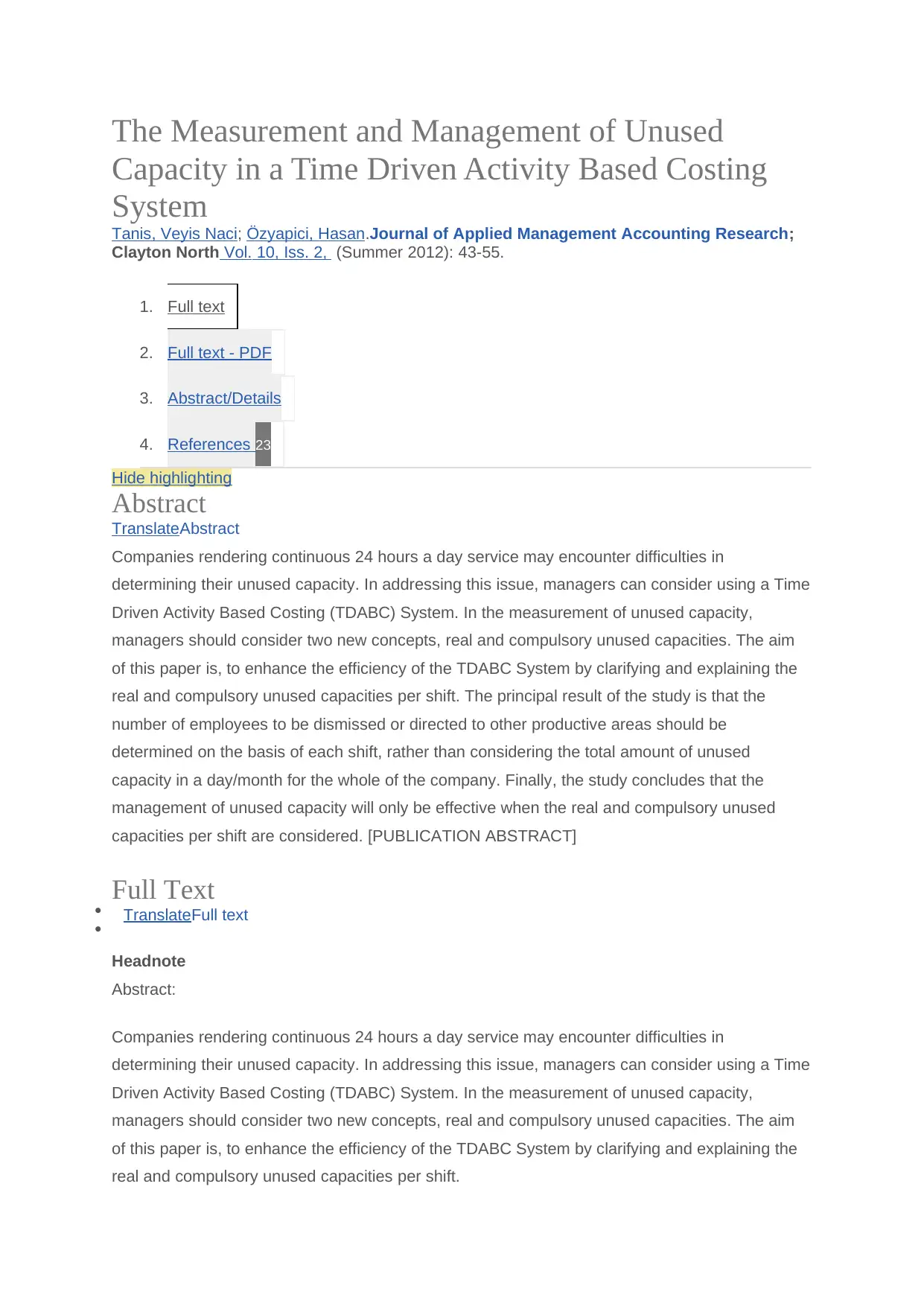
The Measurement and Management of Unused
Capacity in a Time Driven Activity Based Costing
System
Tanis, Veyis Naci; Özyapici, Hasan.Journal of Applied Management Accounting Research;
Clayton North Vol. 10, Iss. 2, (Summer 2012): 43-55.
1. Full text
2. Full text - PDF
3. Abstract/Details
4. References 23
Hide highlighting
Abstract
TranslateAbstract
Companies rendering continuous 24 hours a day service may encounter difficulties in
determining their unused capacity. In addressing this issue, managers can consider using a Time
Driven Activity Based Costing (TDABC) System. In the measurement of unused capacity,
managers should consider two new concepts, real and compulsory unused capacities. The aim
of this paper is, to enhance the efficiency of the TDABC System by clarifying and explaining the
real and compulsory unused capacities per shift. The principal result of the study is that the
number of employees to be dismissed or directed to other productive areas should be
determined on the basis of each shift, rather than considering the total amount of unused
capacity in a day/month for the whole of the company. Finally, the study concludes that the
management of unused capacity will only be effective when the real and compulsory unused
capacities per shift are considered. [PUBLICATION ABSTRACT]
Full Text
TranslateFull text
Headnote
Abstract:
Companies rendering continuous 24 hours a day service may encounter difficulties in
determining their unused capacity. In addressing this issue, managers can consider using a Time
Driven Activity Based Costing (TDABC) System. In the measurement of unused capacity,
managers should consider two new concepts, real and compulsory unused capacities. The aim
of this paper is, to enhance the efficiency of the TDABC System by clarifying and explaining the
real and compulsory unused capacities per shift.
Capacity in a Time Driven Activity Based Costing
System
Tanis, Veyis Naci; Özyapici, Hasan.Journal of Applied Management Accounting Research;
Clayton North Vol. 10, Iss. 2, (Summer 2012): 43-55.
1. Full text
2. Full text - PDF
3. Abstract/Details
4. References 23
Hide highlighting
Abstract
TranslateAbstract
Companies rendering continuous 24 hours a day service may encounter difficulties in
determining their unused capacity. In addressing this issue, managers can consider using a Time
Driven Activity Based Costing (TDABC) System. In the measurement of unused capacity,
managers should consider two new concepts, real and compulsory unused capacities. The aim
of this paper is, to enhance the efficiency of the TDABC System by clarifying and explaining the
real and compulsory unused capacities per shift. The principal result of the study is that the
number of employees to be dismissed or directed to other productive areas should be
determined on the basis of each shift, rather than considering the total amount of unused
capacity in a day/month for the whole of the company. Finally, the study concludes that the
management of unused capacity will only be effective when the real and compulsory unused
capacities per shift are considered. [PUBLICATION ABSTRACT]
Full Text
TranslateFull text
Headnote
Abstract:
Companies rendering continuous 24 hours a day service may encounter difficulties in
determining their unused capacity. In addressing this issue, managers can consider using a Time
Driven Activity Based Costing (TDABC) System. In the measurement of unused capacity,
managers should consider two new concepts, real and compulsory unused capacities. The aim
of this paper is, to enhance the efficiency of the TDABC System by clarifying and explaining the
real and compulsory unused capacities per shift.
Paraphrase This Document
Need a fresh take? Get an instant paraphrase of this document with our AI Paraphraser
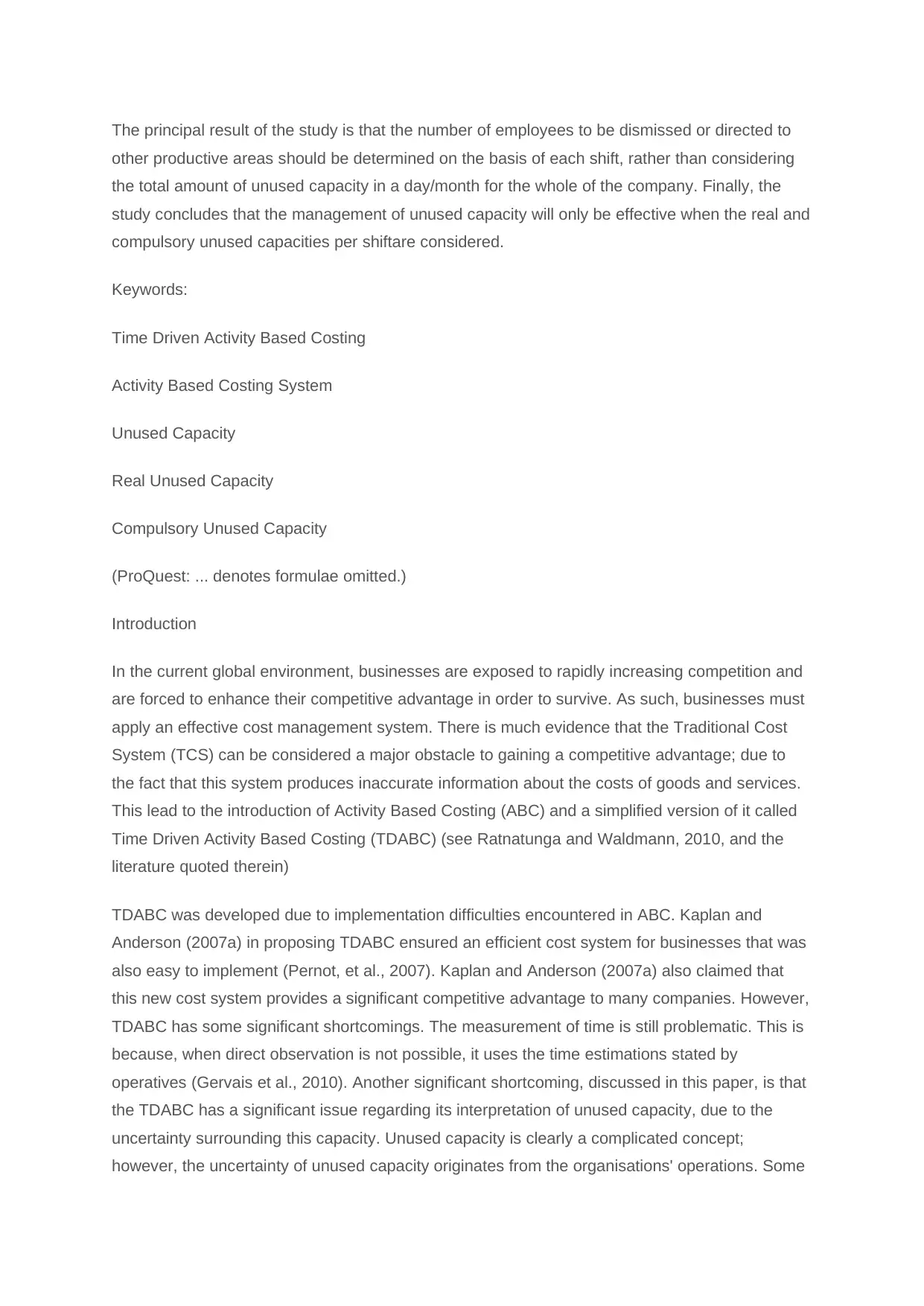
The principal result of the study is that the number of employees to be dismissed or directed to
other productive areas should be determined on the basis of each shift, rather than considering
the total amount of unused capacity in a day/month for the whole of the company. Finally, the
study concludes that the management of unused capacity will only be effective when the real and
compulsory unused capacities per shiftare considered.
Keywords:
Time Driven Activity Based Costing
Activity Based Costing System
Unused Capacity
Real Unused Capacity
Compulsory Unused Capacity
(ProQuest: ... denotes formulae omitted.)
Introduction
In the current global environment, businesses are exposed to rapidly increasing competition and
are forced to enhance their competitive advantage in order to survive. As such, businesses must
apply an effective cost management system. There is much evidence that the Traditional Cost
System (TCS) can be considered a major obstacle to gaining a competitive advantage; due to
the fact that this system produces inaccurate information about the costs of goods and services.
This lead to the introduction of Activity Based Costing (ABC) and a simplified version of it called
Time Driven Activity Based Costing (TDABC) (see Ratnatunga and Waldmann, 2010, and the
literature quoted therein)
TDABC was developed due to implementation difficulties encountered in ABC. Kaplan and
Anderson (2007a) in proposing TDABC ensured an efficient cost system for businesses that was
also easy to implement (Pernot, et al., 2007). Kaplan and Anderson (2007a) also claimed that
this new cost system provides a significant competitive advantage to many companies. However,
TDABC has some significant shortcomings. The measurement of time is still problematic. This is
because, when direct observation is not possible, it uses the time estimations stated by
operatives (Gervais et al., 2010). Another significant shortcoming, discussed in this paper, is that
the TDABC has a significant issue regarding its interpretation of unused capacity, due to the
uncertainty surrounding this capacity. Unused capacity is clearly a complicated concept;
however, the uncertainty of unused capacity originates from the organisations' operations. Some
other productive areas should be determined on the basis of each shift, rather than considering
the total amount of unused capacity in a day/month for the whole of the company. Finally, the
study concludes that the management of unused capacity will only be effective when the real and
compulsory unused capacities per shiftare considered.
Keywords:
Time Driven Activity Based Costing
Activity Based Costing System
Unused Capacity
Real Unused Capacity
Compulsory Unused Capacity
(ProQuest: ... denotes formulae omitted.)
Introduction
In the current global environment, businesses are exposed to rapidly increasing competition and
are forced to enhance their competitive advantage in order to survive. As such, businesses must
apply an effective cost management system. There is much evidence that the Traditional Cost
System (TCS) can be considered a major obstacle to gaining a competitive advantage; due to
the fact that this system produces inaccurate information about the costs of goods and services.
This lead to the introduction of Activity Based Costing (ABC) and a simplified version of it called
Time Driven Activity Based Costing (TDABC) (see Ratnatunga and Waldmann, 2010, and the
literature quoted therein)
TDABC was developed due to implementation difficulties encountered in ABC. Kaplan and
Anderson (2007a) in proposing TDABC ensured an efficient cost system for businesses that was
also easy to implement (Pernot, et al., 2007). Kaplan and Anderson (2007a) also claimed that
this new cost system provides a significant competitive advantage to many companies. However,
TDABC has some significant shortcomings. The measurement of time is still problematic. This is
because, when direct observation is not possible, it uses the time estimations stated by
operatives (Gervais et al., 2010). Another significant shortcoming, discussed in this paper, is that
the TDABC has a significant issue regarding its interpretation of unused capacity, due to the
uncertainty surrounding this capacity. Unused capacity is clearly a complicated concept;
however, the uncertainty of unused capacity originates from the organisations' operations. Some
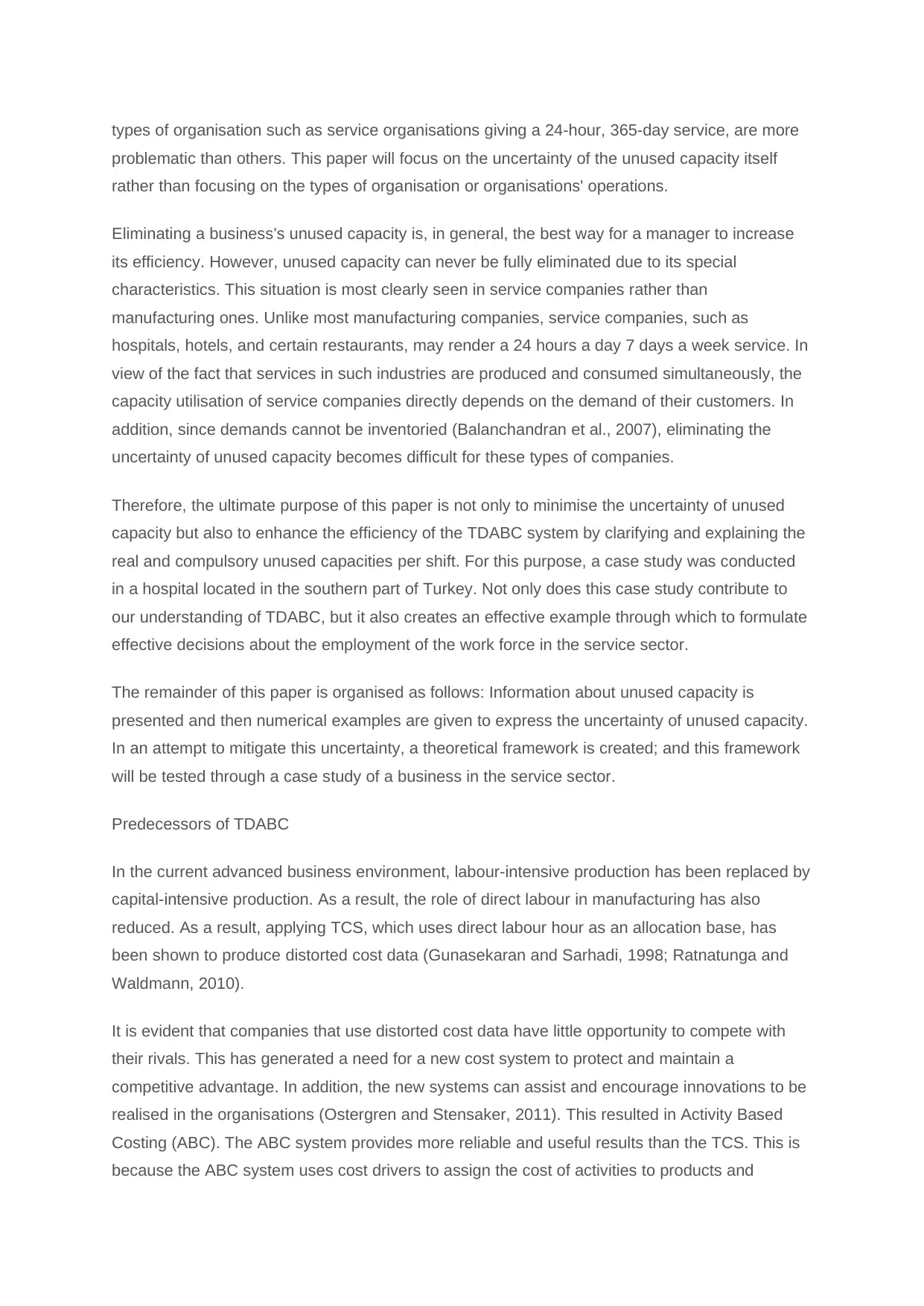
types of organisation such as service organisations giving a 24-hour, 365-day service, are more
problematic than others. This paper will focus on the uncertainty of the unused capacity itself
rather than focusing on the types of organisation or organisations' operations.
Eliminating a business's unused capacity is, in general, the best way for a manager to increase
its efficiency. However, unused capacity can never be fully eliminated due to its special
characteristics. This situation is most clearly seen in service companies rather than
manufacturing ones. Unlike most manufacturing companies, service companies, such as
hospitals, hotels, and certain restaurants, may render a 24 hours a day 7 days a week service. In
view of the fact that services in such industries are produced and consumed simultaneously, the
capacity utilisation of service companies directly depends on the demand of their customers. In
addition, since demands cannot be inventoried (Balanchandran et al., 2007), eliminating the
uncertainty of unused capacity becomes difficult for these types of companies.
Therefore, the ultimate purpose of this paper is not only to minimise the uncertainty of unused
capacity but also to enhance the efficiency of the TDABC system by clarifying and explaining the
real and compulsory unused capacities per shift. For this purpose, a case study was conducted
in a hospital located in the southern part of Turkey. Not only does this case study contribute to
our understanding of TDABC, but it also creates an effective example through which to formulate
effective decisions about the employment of the work force in the service sector.
The remainder of this paper is organised as follows: Information about unused capacity is
presented and then numerical examples are given to express the uncertainty of unused capacity.
In an attempt to mitigate this uncertainty, a theoretical framework is created; and this framework
will be tested through a case study of a business in the service sector.
Predecessors of TDABC
In the current advanced business environment, labour-intensive production has been replaced by
capital-intensive production. As a result, the role of direct labour in manufacturing has also
reduced. As a result, applying TCS, which uses direct labour hour as an allocation base, has
been shown to produce distorted cost data (Gunasekaran and Sarhadi, 1998; Ratnatunga and
Waldmann, 2010).
It is evident that companies that use distorted cost data have little opportunity to compete with
their rivals. This has generated a need for a new cost system to protect and maintain a
competitive advantage. In addition, the new systems can assist and encourage innovations to be
realised in the organisations (Ostergren and Stensaker, 2011). This resulted in Activity Based
Costing (ABC). The ABC system provides more reliable and useful results than the TCS. This is
because the ABC system uses cost drivers to assign the cost of activities to products and
problematic than others. This paper will focus on the uncertainty of the unused capacity itself
rather than focusing on the types of organisation or organisations' operations.
Eliminating a business's unused capacity is, in general, the best way for a manager to increase
its efficiency. However, unused capacity can never be fully eliminated due to its special
characteristics. This situation is most clearly seen in service companies rather than
manufacturing ones. Unlike most manufacturing companies, service companies, such as
hospitals, hotels, and certain restaurants, may render a 24 hours a day 7 days a week service. In
view of the fact that services in such industries are produced and consumed simultaneously, the
capacity utilisation of service companies directly depends on the demand of their customers. In
addition, since demands cannot be inventoried (Balanchandran et al., 2007), eliminating the
uncertainty of unused capacity becomes difficult for these types of companies.
Therefore, the ultimate purpose of this paper is not only to minimise the uncertainty of unused
capacity but also to enhance the efficiency of the TDABC system by clarifying and explaining the
real and compulsory unused capacities per shift. For this purpose, a case study was conducted
in a hospital located in the southern part of Turkey. Not only does this case study contribute to
our understanding of TDABC, but it also creates an effective example through which to formulate
effective decisions about the employment of the work force in the service sector.
The remainder of this paper is organised as follows: Information about unused capacity is
presented and then numerical examples are given to express the uncertainty of unused capacity.
In an attempt to mitigate this uncertainty, a theoretical framework is created; and this framework
will be tested through a case study of a business in the service sector.
Predecessors of TDABC
In the current advanced business environment, labour-intensive production has been replaced by
capital-intensive production. As a result, the role of direct labour in manufacturing has also
reduced. As a result, applying TCS, which uses direct labour hour as an allocation base, has
been shown to produce distorted cost data (Gunasekaran and Sarhadi, 1998; Ratnatunga and
Waldmann, 2010).
It is evident that companies that use distorted cost data have little opportunity to compete with
their rivals. This has generated a need for a new cost system to protect and maintain a
competitive advantage. In addition, the new systems can assist and encourage innovations to be
realised in the organisations (Ostergren and Stensaker, 2011). This resulted in Activity Based
Costing (ABC). The ABC system provides more reliable and useful results than the TCS. This is
because the ABC system uses cost drivers to assign the cost of activities to products and
⊘ This is a preview!⊘
Do you want full access?
Subscribe today to unlock all pages.

Trusted by 1+ million students worldwide
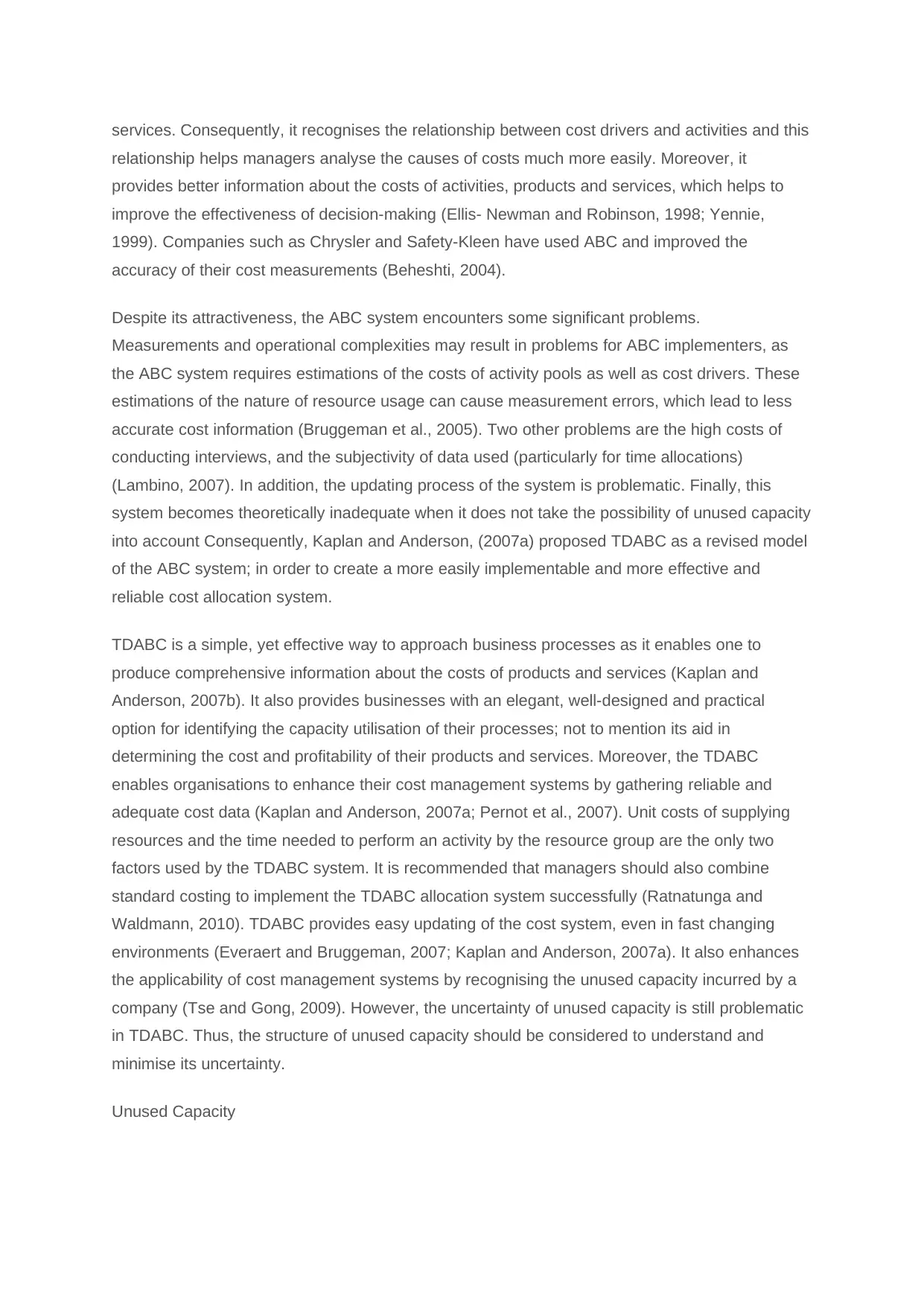
services. Consequently, it recognises the relationship between cost drivers and activities and this
relationship helps managers analyse the causes of costs much more easily. Moreover, it
provides better information about the costs of activities, products and services, which helps to
improve the effectiveness of decision-making (Ellis- Newman and Robinson, 1998; Yennie,
1999). Companies such as Chrysler and Safety-Kleen have used ABC and improved the
accuracy of their cost measurements (Beheshti, 2004).
Despite its attractiveness, the ABC system encounters some significant problems.
Measurements and operational complexities may result in problems for ABC implementers, as
the ABC system requires estimations of the costs of activity pools as well as cost drivers. These
estimations of the nature of resource usage can cause measurement errors, which lead to less
accurate cost information (Bruggeman et al., 2005). Two other problems are the high costs of
conducting interviews, and the subjectivity of data used (particularly for time allocations)
(Lambino, 2007). In addition, the updating process of the system is problematic. Finally, this
system becomes theoretically inadequate when it does not take the possibility of unused capacity
into account Consequently, Kaplan and Anderson, (2007a) proposed TDABC as a revised model
of the ABC system; in order to create a more easily implementable and more effective and
reliable cost allocation system.
TDABC is a simple, yet effective way to approach business processes as it enables one to
produce comprehensive information about the costs of products and services (Kaplan and
Anderson, 2007b). It also provides businesses with an elegant, well-designed and practical
option for identifying the capacity utilisation of their processes; not to mention its aid in
determining the cost and profitability of their products and services. Moreover, the TDABC
enables organisations to enhance their cost management systems by gathering reliable and
adequate cost data (Kaplan and Anderson, 2007a; Pernot et al., 2007). Unit costs of supplying
resources and the time needed to perform an activity by the resource group are the only two
factors used by the TDABC system. It is recommended that managers should also combine
standard costing to implement the TDABC allocation system successfully (Ratnatunga and
Waldmann, 2010). TDABC provides easy updating of the cost system, even in fast changing
environments (Everaert and Bruggeman, 2007; Kaplan and Anderson, 2007a). It also enhances
the applicability of cost management systems by recognising the unused capacity incurred by a
company (Tse and Gong, 2009). However, the uncertainty of unused capacity is still problematic
in TDABC. Thus, the structure of unused capacity should be considered to understand and
minimise its uncertainty.
Unused Capacity
relationship helps managers analyse the causes of costs much more easily. Moreover, it
provides better information about the costs of activities, products and services, which helps to
improve the effectiveness of decision-making (Ellis- Newman and Robinson, 1998; Yennie,
1999). Companies such as Chrysler and Safety-Kleen have used ABC and improved the
accuracy of their cost measurements (Beheshti, 2004).
Despite its attractiveness, the ABC system encounters some significant problems.
Measurements and operational complexities may result in problems for ABC implementers, as
the ABC system requires estimations of the costs of activity pools as well as cost drivers. These
estimations of the nature of resource usage can cause measurement errors, which lead to less
accurate cost information (Bruggeman et al., 2005). Two other problems are the high costs of
conducting interviews, and the subjectivity of data used (particularly for time allocations)
(Lambino, 2007). In addition, the updating process of the system is problematic. Finally, this
system becomes theoretically inadequate when it does not take the possibility of unused capacity
into account Consequently, Kaplan and Anderson, (2007a) proposed TDABC as a revised model
of the ABC system; in order to create a more easily implementable and more effective and
reliable cost allocation system.
TDABC is a simple, yet effective way to approach business processes as it enables one to
produce comprehensive information about the costs of products and services (Kaplan and
Anderson, 2007b). It also provides businesses with an elegant, well-designed and practical
option for identifying the capacity utilisation of their processes; not to mention its aid in
determining the cost and profitability of their products and services. Moreover, the TDABC
enables organisations to enhance their cost management systems by gathering reliable and
adequate cost data (Kaplan and Anderson, 2007a; Pernot et al., 2007). Unit costs of supplying
resources and the time needed to perform an activity by the resource group are the only two
factors used by the TDABC system. It is recommended that managers should also combine
standard costing to implement the TDABC allocation system successfully (Ratnatunga and
Waldmann, 2010). TDABC provides easy updating of the cost system, even in fast changing
environments (Everaert and Bruggeman, 2007; Kaplan and Anderson, 2007a). It also enhances
the applicability of cost management systems by recognising the unused capacity incurred by a
company (Tse and Gong, 2009). However, the uncertainty of unused capacity is still problematic
in TDABC. Thus, the structure of unused capacity should be considered to understand and
minimise its uncertainty.
Unused Capacity
Paraphrase This Document
Need a fresh take? Get an instant paraphrase of this document with our AI Paraphraser
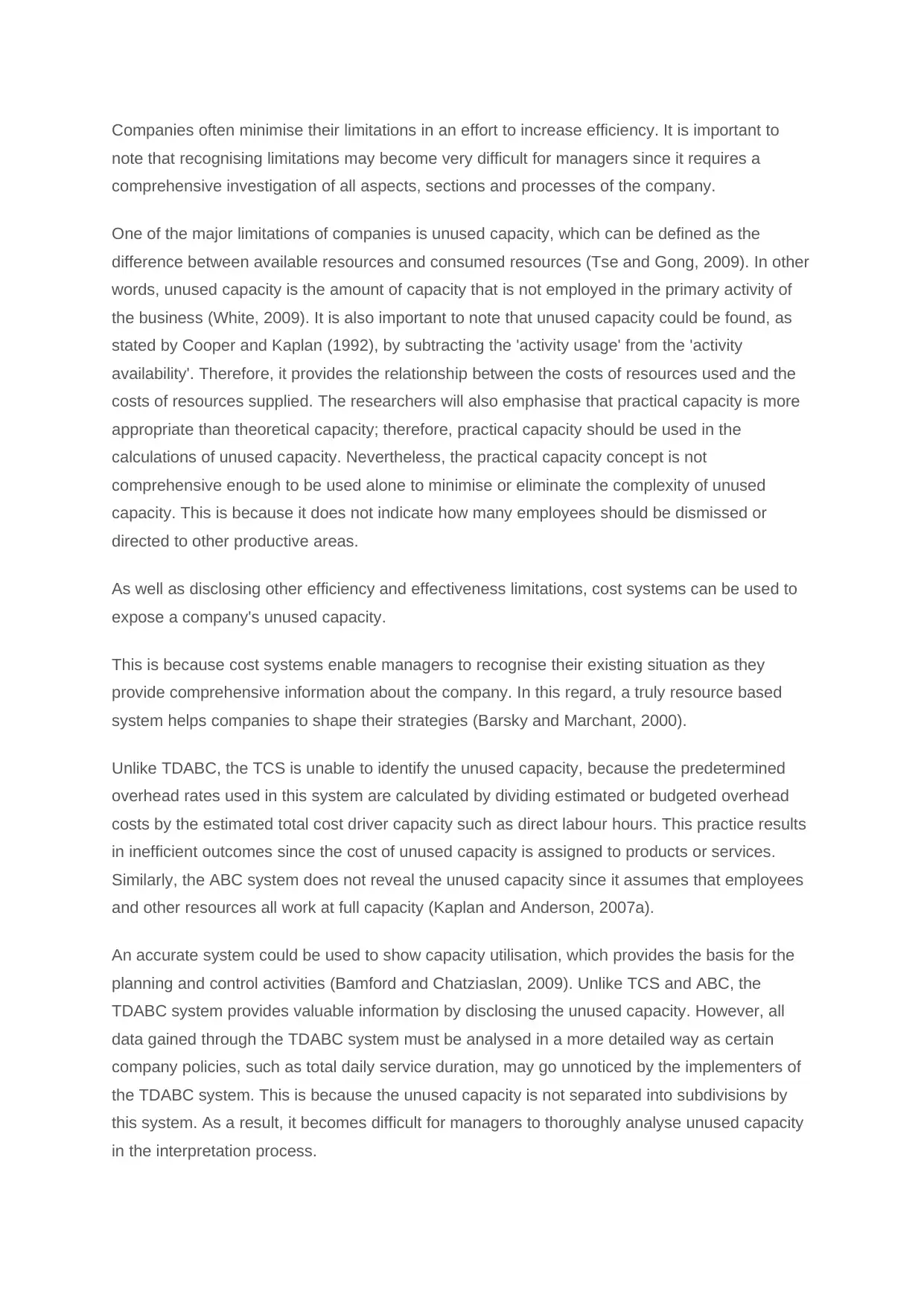
Companies often minimise their limitations in an effort to increase efficiency. It is important to
note that recognising limitations may become very difficult for managers since it requires a
comprehensive investigation of all aspects, sections and processes of the company.
One of the major limitations of companies is unused capacity, which can be defined as the
difference between available resources and consumed resources (Tse and Gong, 2009). In other
words, unused capacity is the amount of capacity that is not employed in the primary activity of
the business (White, 2009). It is also important to note that unused capacity could be found, as
stated by Cooper and Kaplan (1992), by subtracting the 'activity usage' from the 'activity
availability'. Therefore, it provides the relationship between the costs of resources used and the
costs of resources supplied. The researchers will also emphasise that practical capacity is more
appropriate than theoretical capacity; therefore, practical capacity should be used in the
calculations of unused capacity. Nevertheless, the practical capacity concept is not
comprehensive enough to be used alone to minimise or eliminate the complexity of unused
capacity. This is because it does not indicate how many employees should be dismissed or
directed to other productive areas.
As well as disclosing other efficiency and effectiveness limitations, cost systems can be used to
expose a company's unused capacity.
This is because cost systems enable managers to recognise their existing situation as they
provide comprehensive information about the company. In this regard, a truly resource based
system helps companies to shape their strategies (Barsky and Marchant, 2000).
Unlike TDABC, the TCS is unable to identify the unused capacity, because the predetermined
overhead rates used in this system are calculated by dividing estimated or budgeted overhead
costs by the estimated total cost driver capacity such as direct labour hours. This practice results
in inefficient outcomes since the cost of unused capacity is assigned to products or services.
Similarly, the ABC system does not reveal the unused capacity since it assumes that employees
and other resources all work at full capacity (Kaplan and Anderson, 2007a).
An accurate system could be used to show capacity utilisation, which provides the basis for the
planning and control activities (Bamford and Chatziaslan, 2009). Unlike TCS and ABC, the
TDABC system provides valuable information by disclosing the unused capacity. However, all
data gained through the TDABC system must be analysed in a more detailed way as certain
company policies, such as total daily service duration, may go unnoticed by the implementers of
the TDABC system. This is because the unused capacity is not separated into subdivisions by
this system. As a result, it becomes difficult for managers to thoroughly analyse unused capacity
in the interpretation process.
note that recognising limitations may become very difficult for managers since it requires a
comprehensive investigation of all aspects, sections and processes of the company.
One of the major limitations of companies is unused capacity, which can be defined as the
difference between available resources and consumed resources (Tse and Gong, 2009). In other
words, unused capacity is the amount of capacity that is not employed in the primary activity of
the business (White, 2009). It is also important to note that unused capacity could be found, as
stated by Cooper and Kaplan (1992), by subtracting the 'activity usage' from the 'activity
availability'. Therefore, it provides the relationship between the costs of resources used and the
costs of resources supplied. The researchers will also emphasise that practical capacity is more
appropriate than theoretical capacity; therefore, practical capacity should be used in the
calculations of unused capacity. Nevertheless, the practical capacity concept is not
comprehensive enough to be used alone to minimise or eliminate the complexity of unused
capacity. This is because it does not indicate how many employees should be dismissed or
directed to other productive areas.
As well as disclosing other efficiency and effectiveness limitations, cost systems can be used to
expose a company's unused capacity.
This is because cost systems enable managers to recognise their existing situation as they
provide comprehensive information about the company. In this regard, a truly resource based
system helps companies to shape their strategies (Barsky and Marchant, 2000).
Unlike TDABC, the TCS is unable to identify the unused capacity, because the predetermined
overhead rates used in this system are calculated by dividing estimated or budgeted overhead
costs by the estimated total cost driver capacity such as direct labour hours. This practice results
in inefficient outcomes since the cost of unused capacity is assigned to products or services.
Similarly, the ABC system does not reveal the unused capacity since it assumes that employees
and other resources all work at full capacity (Kaplan and Anderson, 2007a).
An accurate system could be used to show capacity utilisation, which provides the basis for the
planning and control activities (Bamford and Chatziaslan, 2009). Unlike TCS and ABC, the
TDABC system provides valuable information by disclosing the unused capacity. However, all
data gained through the TDABC system must be analysed in a more detailed way as certain
company policies, such as total daily service duration, may go unnoticed by the implementers of
the TDABC system. This is because the unused capacity is not separated into subdivisions by
this system. As a result, it becomes difficult for managers to thoroughly analyse unused capacity
in the interpretation process.
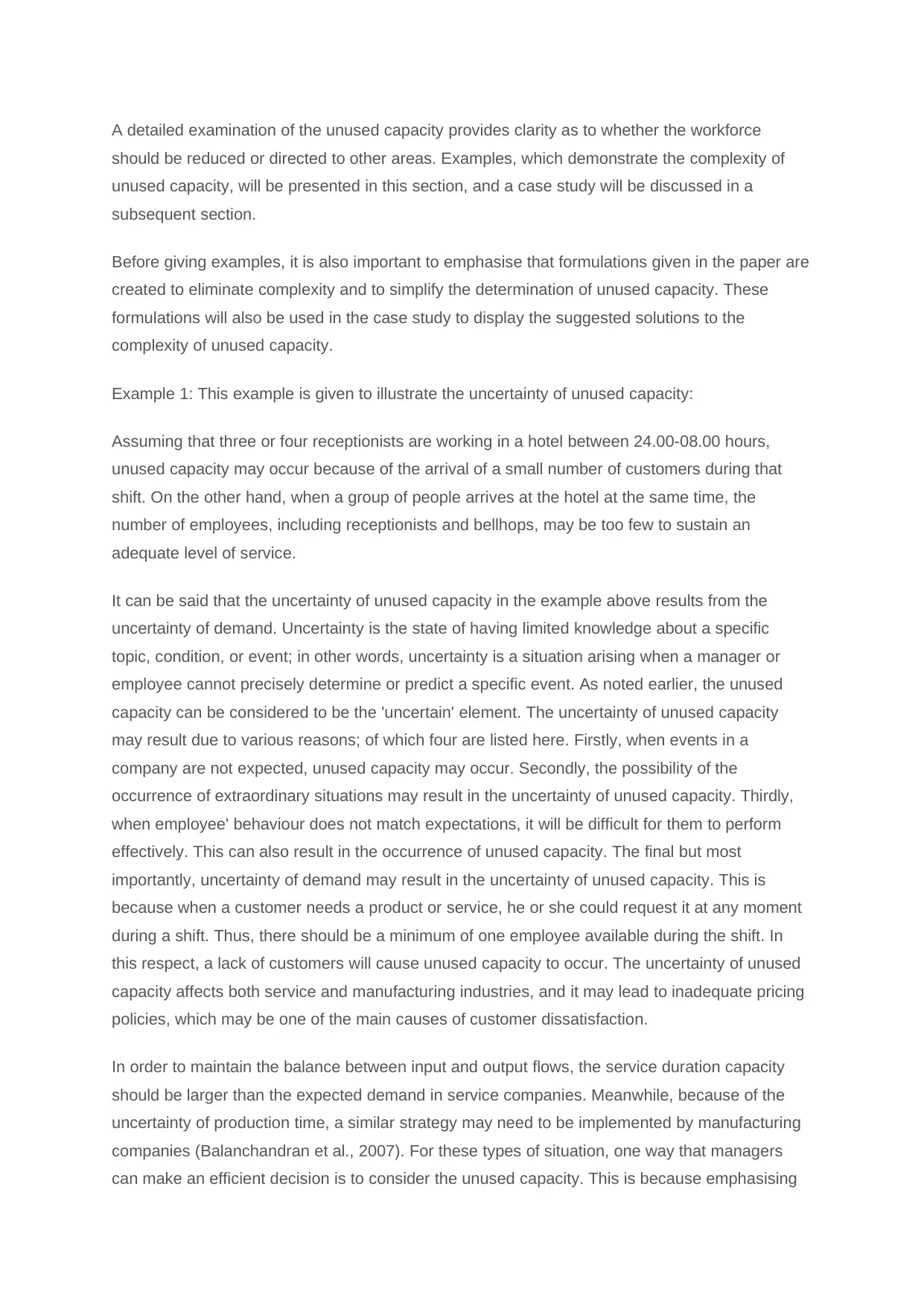
A detailed examination of the unused capacity provides clarity as to whether the workforce
should be reduced or directed to other areas. Examples, which demonstrate the complexity of
unused capacity, will be presented in this section, and a case study will be discussed in a
subsequent section.
Before giving examples, it is also important to emphasise that formulations given in the paper are
created to eliminate complexity and to simplify the determination of unused capacity. These
formulations will also be used in the case study to display the suggested solutions to the
complexity of unused capacity.
Example 1: This example is given to illustrate the uncertainty of unused capacity:
Assuming that three or four receptionists are working in a hotel between 24.00-08.00 hours,
unused capacity may occur because of the arrival of a small number of customers during that
shift. On the other hand, when a group of people arrives at the hotel at the same time, the
number of employees, including receptionists and bellhops, may be too few to sustain an
adequate level of service.
It can be said that the uncertainty of unused capacity in the example above results from the
uncertainty of demand. Uncertainty is the state of having limited knowledge about a specific
topic, condition, or event; in other words, uncertainty is a situation arising when a manager or
employee cannot precisely determine or predict a specific event. As noted earlier, the unused
capacity can be considered to be the 'uncertain' element. The uncertainty of unused capacity
may result due to various reasons; of which four are listed here. Firstly, when events in a
company are not expected, unused capacity may occur. Secondly, the possibility of the
occurrence of extraordinary situations may result in the uncertainty of unused capacity. Thirdly,
when employee' behaviour does not match expectations, it will be difficult for them to perform
effectively. This can also result in the occurrence of unused capacity. The final but most
importantly, uncertainty of demand may result in the uncertainty of unused capacity. This is
because when a customer needs a product or service, he or she could request it at any moment
during a shift. Thus, there should be a minimum of one employee available during the shift. In
this respect, a lack of customers will cause unused capacity to occur. The uncertainty of unused
capacity affects both service and manufacturing industries, and it may lead to inadequate pricing
policies, which may be one of the main causes of customer dissatisfaction.
In order to maintain the balance between input and output flows, the service duration capacity
should be larger than the expected demand in service companies. Meanwhile, because of the
uncertainty of production time, a similar strategy may need to be implemented by manufacturing
companies (Balanchandran et al., 2007). For these types of situation, one way that managers
can make an efficient decision is to consider the unused capacity. This is because emphasising
should be reduced or directed to other areas. Examples, which demonstrate the complexity of
unused capacity, will be presented in this section, and a case study will be discussed in a
subsequent section.
Before giving examples, it is also important to emphasise that formulations given in the paper are
created to eliminate complexity and to simplify the determination of unused capacity. These
formulations will also be used in the case study to display the suggested solutions to the
complexity of unused capacity.
Example 1: This example is given to illustrate the uncertainty of unused capacity:
Assuming that three or four receptionists are working in a hotel between 24.00-08.00 hours,
unused capacity may occur because of the arrival of a small number of customers during that
shift. On the other hand, when a group of people arrives at the hotel at the same time, the
number of employees, including receptionists and bellhops, may be too few to sustain an
adequate level of service.
It can be said that the uncertainty of unused capacity in the example above results from the
uncertainty of demand. Uncertainty is the state of having limited knowledge about a specific
topic, condition, or event; in other words, uncertainty is a situation arising when a manager or
employee cannot precisely determine or predict a specific event. As noted earlier, the unused
capacity can be considered to be the 'uncertain' element. The uncertainty of unused capacity
may result due to various reasons; of which four are listed here. Firstly, when events in a
company are not expected, unused capacity may occur. Secondly, the possibility of the
occurrence of extraordinary situations may result in the uncertainty of unused capacity. Thirdly,
when employee' behaviour does not match expectations, it will be difficult for them to perform
effectively. This can also result in the occurrence of unused capacity. The final but most
importantly, uncertainty of demand may result in the uncertainty of unused capacity. This is
because when a customer needs a product or service, he or she could request it at any moment
during a shift. Thus, there should be a minimum of one employee available during the shift. In
this respect, a lack of customers will cause unused capacity to occur. The uncertainty of unused
capacity affects both service and manufacturing industries, and it may lead to inadequate pricing
policies, which may be one of the main causes of customer dissatisfaction.
In order to maintain the balance between input and output flows, the service duration capacity
should be larger than the expected demand in service companies. Meanwhile, because of the
uncertainty of production time, a similar strategy may need to be implemented by manufacturing
companies (Balanchandran et al., 2007). For these types of situation, one way that managers
can make an efficient decision is to consider the unused capacity. This is because emphasising
⊘ This is a preview!⊘
Do you want full access?
Subscribe today to unlock all pages.

Trusted by 1+ million students worldwide
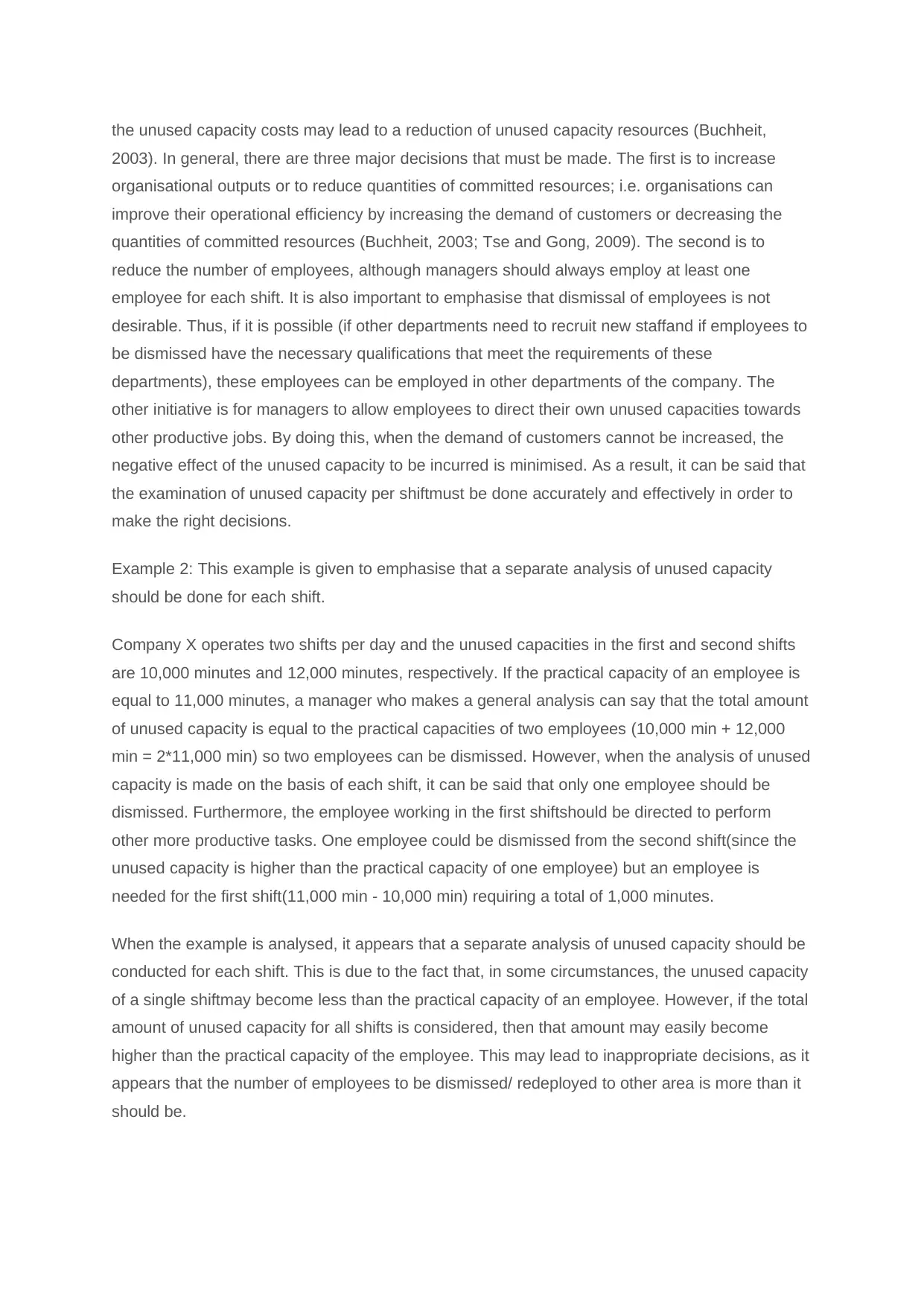
the unused capacity costs may lead to a reduction of unused capacity resources (Buchheit,
2003). In general, there are three major decisions that must be made. The first is to increase
organisational outputs or to reduce quantities of committed resources; i.e. organisations can
improve their operational efficiency by increasing the demand of customers or decreasing the
quantities of committed resources (Buchheit, 2003; Tse and Gong, 2009). The second is to
reduce the number of employees, although managers should always employ at least one
employee for each shift. It is also important to emphasise that dismissal of employees is not
desirable. Thus, if it is possible (if other departments need to recruit new staffand if employees to
be dismissed have the necessary qualifications that meet the requirements of these
departments), these employees can be employed in other departments of the company. The
other initiative is for managers to allow employees to direct their own unused capacities towards
other productive jobs. By doing this, when the demand of customers cannot be increased, the
negative effect of the unused capacity to be incurred is minimised. As a result, it can be said that
the examination of unused capacity per shiftmust be done accurately and effectively in order to
make the right decisions.
Example 2: This example is given to emphasise that a separate analysis of unused capacity
should be done for each shift.
Company X operates two shifts per day and the unused capacities in the first and second shifts
are 10,000 minutes and 12,000 minutes, respectively. If the practical capacity of an employee is
equal to 11,000 minutes, a manager who makes a general analysis can say that the total amount
of unused capacity is equal to the practical capacities of two employees (10,000 min + 12,000
min = 2*11,000 min) so two employees can be dismissed. However, when the analysis of unused
capacity is made on the basis of each shift, it can be said that only one employee should be
dismissed. Furthermore, the employee working in the first shiftshould be directed to perform
other more productive tasks. One employee could be dismissed from the second shift(since the
unused capacity is higher than the practical capacity of one employee) but an employee is
needed for the first shift(11,000 min - 10,000 min) requiring a total of 1,000 minutes.
When the example is analysed, it appears that a separate analysis of unused capacity should be
conducted for each shift. This is due to the fact that, in some circumstances, the unused capacity
of a single shiftmay become less than the practical capacity of an employee. However, if the total
amount of unused capacity for all shifts is considered, then that amount may easily become
higher than the practical capacity of the employee. This may lead to inappropriate decisions, as it
appears that the number of employees to be dismissed/ redeployed to other area is more than it
should be.
2003). In general, there are three major decisions that must be made. The first is to increase
organisational outputs or to reduce quantities of committed resources; i.e. organisations can
improve their operational efficiency by increasing the demand of customers or decreasing the
quantities of committed resources (Buchheit, 2003; Tse and Gong, 2009). The second is to
reduce the number of employees, although managers should always employ at least one
employee for each shift. It is also important to emphasise that dismissal of employees is not
desirable. Thus, if it is possible (if other departments need to recruit new staffand if employees to
be dismissed have the necessary qualifications that meet the requirements of these
departments), these employees can be employed in other departments of the company. The
other initiative is for managers to allow employees to direct their own unused capacities towards
other productive jobs. By doing this, when the demand of customers cannot be increased, the
negative effect of the unused capacity to be incurred is minimised. As a result, it can be said that
the examination of unused capacity per shiftmust be done accurately and effectively in order to
make the right decisions.
Example 2: This example is given to emphasise that a separate analysis of unused capacity
should be done for each shift.
Company X operates two shifts per day and the unused capacities in the first and second shifts
are 10,000 minutes and 12,000 minutes, respectively. If the practical capacity of an employee is
equal to 11,000 minutes, a manager who makes a general analysis can say that the total amount
of unused capacity is equal to the practical capacities of two employees (10,000 min + 12,000
min = 2*11,000 min) so two employees can be dismissed. However, when the analysis of unused
capacity is made on the basis of each shift, it can be said that only one employee should be
dismissed. Furthermore, the employee working in the first shiftshould be directed to perform
other more productive tasks. One employee could be dismissed from the second shift(since the
unused capacity is higher than the practical capacity of one employee) but an employee is
needed for the first shift(11,000 min - 10,000 min) requiring a total of 1,000 minutes.
When the example is analysed, it appears that a separate analysis of unused capacity should be
conducted for each shift. This is due to the fact that, in some circumstances, the unused capacity
of a single shiftmay become less than the practical capacity of an employee. However, if the total
amount of unused capacity for all shifts is considered, then that amount may easily become
higher than the practical capacity of the employee. This may lead to inappropriate decisions, as it
appears that the number of employees to be dismissed/ redeployed to other area is more than it
should be.
Paraphrase This Document
Need a fresh take? Get an instant paraphrase of this document with our AI Paraphraser
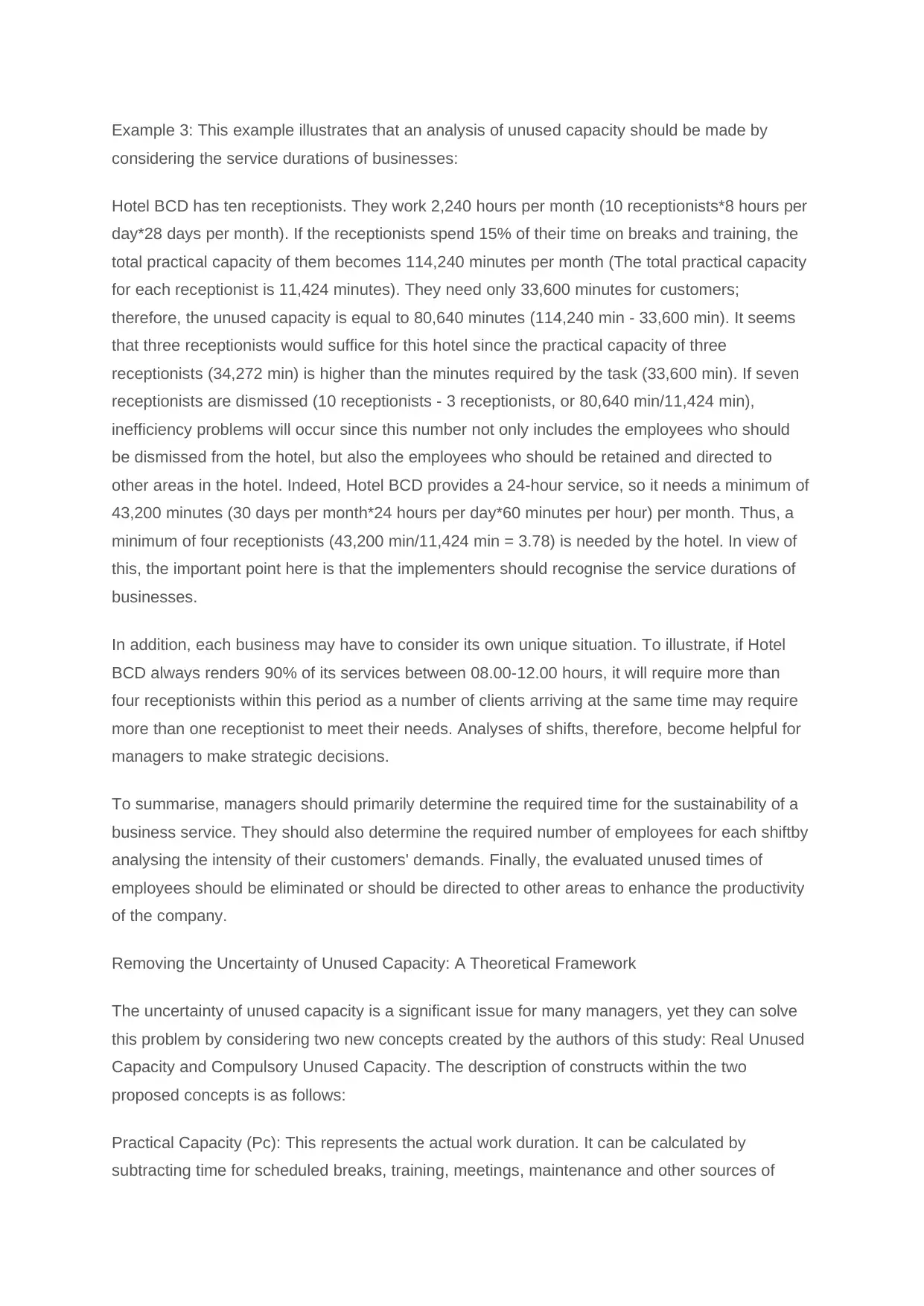
Example 3: This example illustrates that an analysis of unused capacity should be made by
considering the service durations of businesses:
Hotel BCD has ten receptionists. They work 2,240 hours per month (10 receptionists*8 hours per
day*28 days per month). If the receptionists spend 15% of their time on breaks and training, the
total practical capacity of them becomes 114,240 minutes per month (The total practical capacity
for each receptionist is 11,424 minutes). They need only 33,600 minutes for customers;
therefore, the unused capacity is equal to 80,640 minutes (114,240 min - 33,600 min). It seems
that three receptionists would suffice for this hotel since the practical capacity of three
receptionists (34,272 min) is higher than the minutes required by the task (33,600 min). If seven
receptionists are dismissed (10 receptionists - 3 receptionists, or 80,640 min/11,424 min),
inefficiency problems will occur since this number not only includes the employees who should
be dismissed from the hotel, but also the employees who should be retained and directed to
other areas in the hotel. Indeed, Hotel BCD provides a 24-hour service, so it needs a minimum of
43,200 minutes (30 days per month*24 hours per day*60 minutes per hour) per month. Thus, a
minimum of four receptionists (43,200 min/11,424 min = 3.78) is needed by the hotel. In view of
this, the important point here is that the implementers should recognise the service durations of
businesses.
In addition, each business may have to consider its own unique situation. To illustrate, if Hotel
BCD always renders 90% of its services between 08.00-12.00 hours, it will require more than
four receptionists within this period as a number of clients arriving at the same time may require
more than one receptionist to meet their needs. Analyses of shifts, therefore, become helpful for
managers to make strategic decisions.
To summarise, managers should primarily determine the required time for the sustainability of a
business service. They should also determine the required number of employees for each shiftby
analysing the intensity of their customers' demands. Finally, the evaluated unused times of
employees should be eliminated or should be directed to other areas to enhance the productivity
of the company.
Removing the Uncertainty of Unused Capacity: A Theoretical Framework
The uncertainty of unused capacity is a significant issue for many managers, yet they can solve
this problem by considering two new concepts created by the authors of this study: Real Unused
Capacity and Compulsory Unused Capacity. The description of constructs within the two
proposed concepts is as follows:
Practical Capacity (Pc): This represents the actual work duration. It can be calculated by
subtracting time for scheduled breaks, training, meetings, maintenance and other sources of
considering the service durations of businesses:
Hotel BCD has ten receptionists. They work 2,240 hours per month (10 receptionists*8 hours per
day*28 days per month). If the receptionists spend 15% of their time on breaks and training, the
total practical capacity of them becomes 114,240 minutes per month (The total practical capacity
for each receptionist is 11,424 minutes). They need only 33,600 minutes for customers;
therefore, the unused capacity is equal to 80,640 minutes (114,240 min - 33,600 min). It seems
that three receptionists would suffice for this hotel since the practical capacity of three
receptionists (34,272 min) is higher than the minutes required by the task (33,600 min). If seven
receptionists are dismissed (10 receptionists - 3 receptionists, or 80,640 min/11,424 min),
inefficiency problems will occur since this number not only includes the employees who should
be dismissed from the hotel, but also the employees who should be retained and directed to
other areas in the hotel. Indeed, Hotel BCD provides a 24-hour service, so it needs a minimum of
43,200 minutes (30 days per month*24 hours per day*60 minutes per hour) per month. Thus, a
minimum of four receptionists (43,200 min/11,424 min = 3.78) is needed by the hotel. In view of
this, the important point here is that the implementers should recognise the service durations of
businesses.
In addition, each business may have to consider its own unique situation. To illustrate, if Hotel
BCD always renders 90% of its services between 08.00-12.00 hours, it will require more than
four receptionists within this period as a number of clients arriving at the same time may require
more than one receptionist to meet their needs. Analyses of shifts, therefore, become helpful for
managers to make strategic decisions.
To summarise, managers should primarily determine the required time for the sustainability of a
business service. They should also determine the required number of employees for each shiftby
analysing the intensity of their customers' demands. Finally, the evaluated unused times of
employees should be eliminated or should be directed to other areas to enhance the productivity
of the company.
Removing the Uncertainty of Unused Capacity: A Theoretical Framework
The uncertainty of unused capacity is a significant issue for many managers, yet they can solve
this problem by considering two new concepts created by the authors of this study: Real Unused
Capacity and Compulsory Unused Capacity. The description of constructs within the two
proposed concepts is as follows:
Practical Capacity (Pc): This represents the actual work duration. It can be calculated by
subtracting time for scheduled breaks, training, meetings, maintenance and other sources of
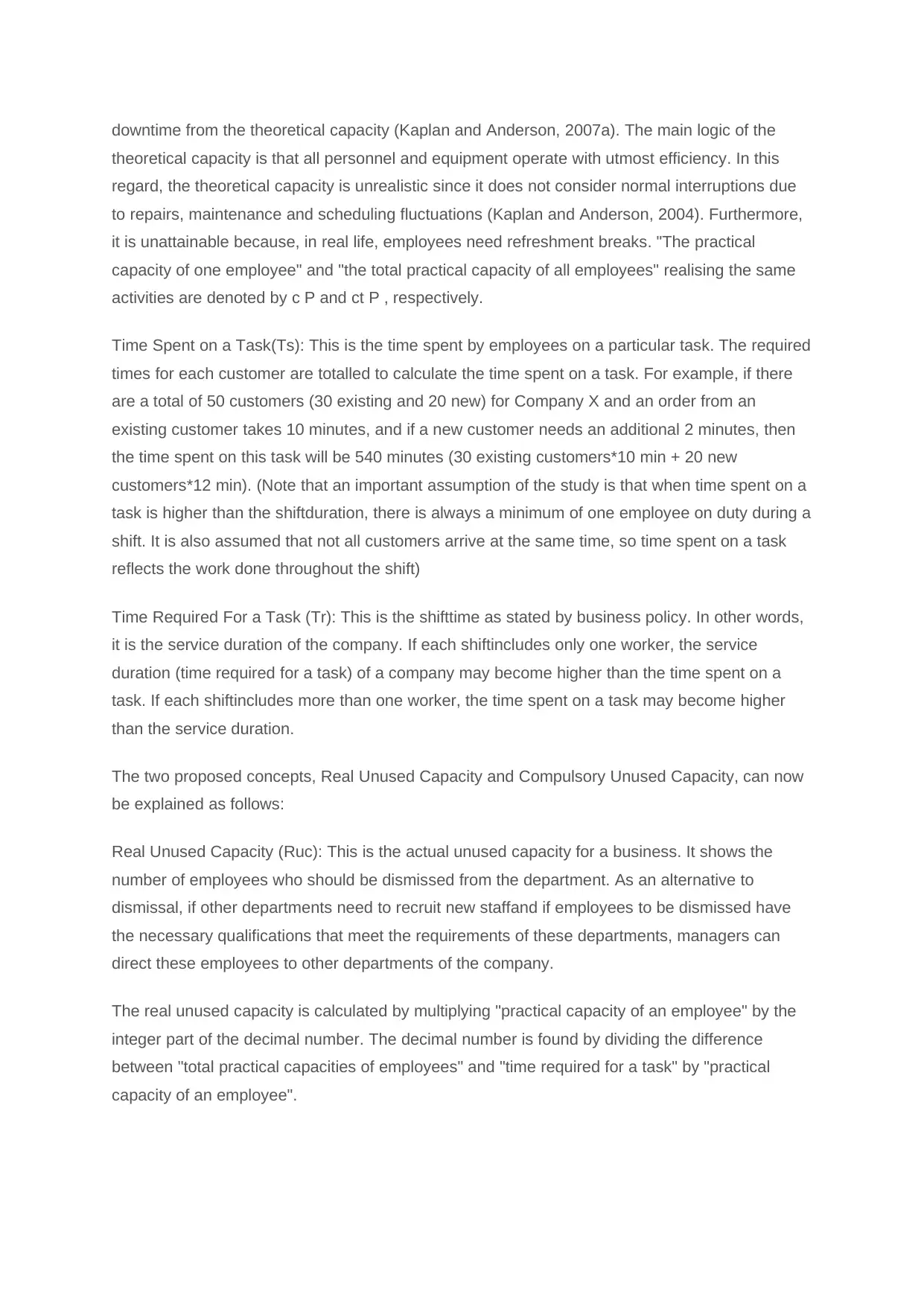
downtime from the theoretical capacity (Kaplan and Anderson, 2007a). The main logic of the
theoretical capacity is that all personnel and equipment operate with utmost efficiency. In this
regard, the theoretical capacity is unrealistic since it does not consider normal interruptions due
to repairs, maintenance and scheduling fluctuations (Kaplan and Anderson, 2004). Furthermore,
it is unattainable because, in real life, employees need refreshment breaks. "The practical
capacity of one employee" and "the total practical capacity of all employees" realising the same
activities are denoted by c P and ct P , respectively.
Time Spent on a Task(Ts): This is the time spent by employees on a particular task. The required
times for each customer are totalled to calculate the time spent on a task. For example, if there
are a total of 50 customers (30 existing and 20 new) for Company X and an order from an
existing customer takes 10 minutes, and if a new customer needs an additional 2 minutes, then
the time spent on this task will be 540 minutes (30 existing customers*10 min + 20 new
customers*12 min). (Note that an important assumption of the study is that when time spent on a
task is higher than the shiftduration, there is always a minimum of one employee on duty during a
shift. It is also assumed that not all customers arrive at the same time, so time spent on a task
reflects the work done throughout the shift)
Time Required For a Task (Tr): This is the shifttime as stated by business policy. In other words,
it is the service duration of the company. If each shiftincludes only one worker, the service
duration (time required for a task) of a company may become higher than the time spent on a
task. If each shiftincludes more than one worker, the time spent on a task may become higher
than the service duration.
The two proposed concepts, Real Unused Capacity and Compulsory Unused Capacity, can now
be explained as follows:
Real Unused Capacity (Ruc): This is the actual unused capacity for a business. It shows the
number of employees who should be dismissed from the department. As an alternative to
dismissal, if other departments need to recruit new staffand if employees to be dismissed have
the necessary qualifications that meet the requirements of these departments, managers can
direct these employees to other departments of the company.
The real unused capacity is calculated by multiplying "practical capacity of an employee" by the
integer part of the decimal number. The decimal number is found by dividing the difference
between "total practical capacities of employees" and "time required for a task" by "practical
capacity of an employee".
theoretical capacity is that all personnel and equipment operate with utmost efficiency. In this
regard, the theoretical capacity is unrealistic since it does not consider normal interruptions due
to repairs, maintenance and scheduling fluctuations (Kaplan and Anderson, 2004). Furthermore,
it is unattainable because, in real life, employees need refreshment breaks. "The practical
capacity of one employee" and "the total practical capacity of all employees" realising the same
activities are denoted by c P and ct P , respectively.
Time Spent on a Task(Ts): This is the time spent by employees on a particular task. The required
times for each customer are totalled to calculate the time spent on a task. For example, if there
are a total of 50 customers (30 existing and 20 new) for Company X and an order from an
existing customer takes 10 minutes, and if a new customer needs an additional 2 minutes, then
the time spent on this task will be 540 minutes (30 existing customers*10 min + 20 new
customers*12 min). (Note that an important assumption of the study is that when time spent on a
task is higher than the shiftduration, there is always a minimum of one employee on duty during a
shift. It is also assumed that not all customers arrive at the same time, so time spent on a task
reflects the work done throughout the shift)
Time Required For a Task (Tr): This is the shifttime as stated by business policy. In other words,
it is the service duration of the company. If each shiftincludes only one worker, the service
duration (time required for a task) of a company may become higher than the time spent on a
task. If each shiftincludes more than one worker, the time spent on a task may become higher
than the service duration.
The two proposed concepts, Real Unused Capacity and Compulsory Unused Capacity, can now
be explained as follows:
Real Unused Capacity (Ruc): This is the actual unused capacity for a business. It shows the
number of employees who should be dismissed from the department. As an alternative to
dismissal, if other departments need to recruit new staffand if employees to be dismissed have
the necessary qualifications that meet the requirements of these departments, managers can
direct these employees to other departments of the company.
The real unused capacity is calculated by multiplying "practical capacity of an employee" by the
integer part of the decimal number. The decimal number is found by dividing the difference
between "total practical capacities of employees" and "time required for a task" by "practical
capacity of an employee".
⊘ This is a preview!⊘
Do you want full access?
Subscribe today to unlock all pages.

Trusted by 1+ million students worldwide
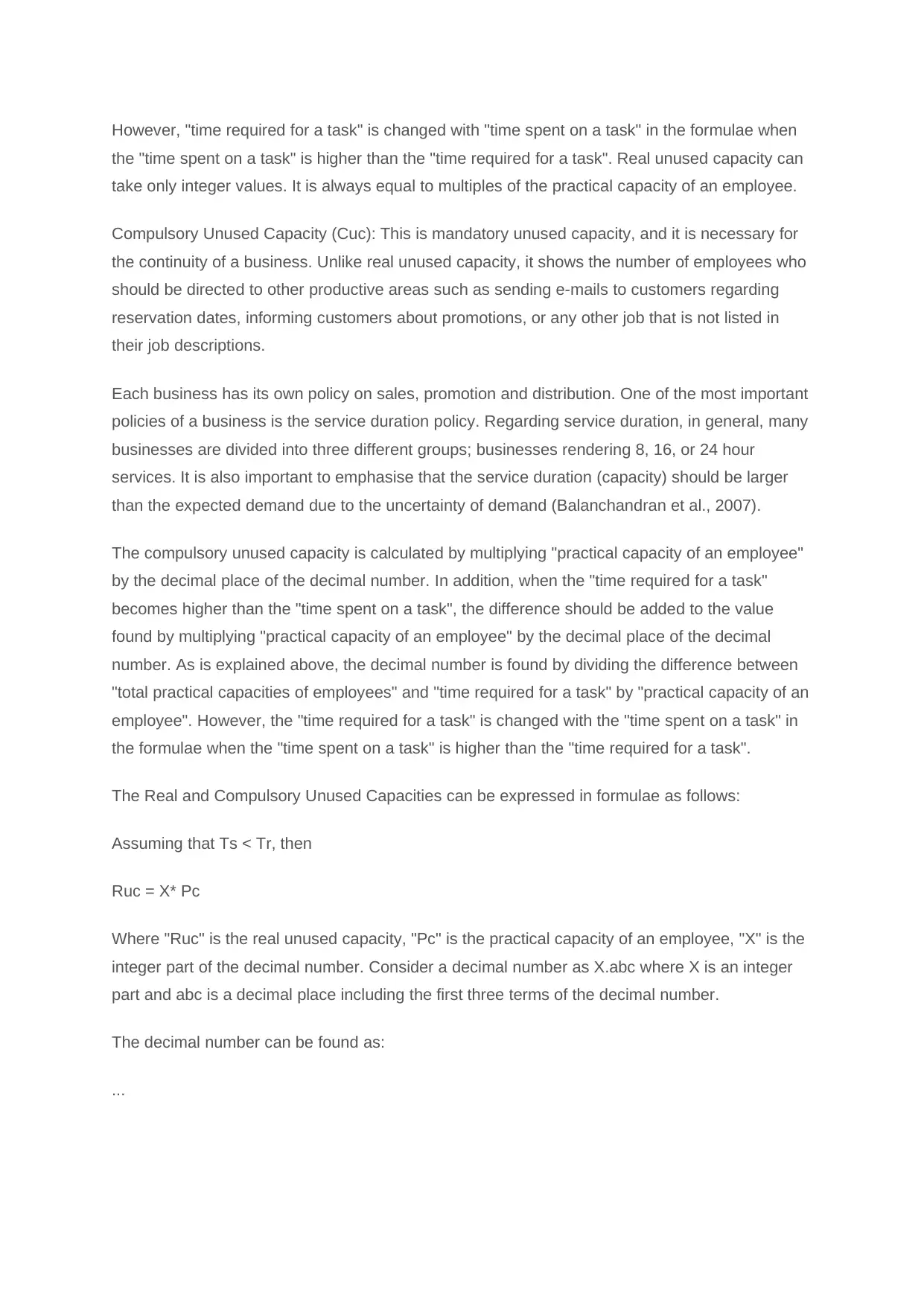
However, "time required for a task" is changed with "time spent on a task" in the formulae when
the "time spent on a task" is higher than the "time required for a task". Real unused capacity can
take only integer values. It is always equal to multiples of the practical capacity of an employee.
Compulsory Unused Capacity (Cuc): This is mandatory unused capacity, and it is necessary for
the continuity of a business. Unlike real unused capacity, it shows the number of employees who
should be directed to other productive areas such as sending e-mails to customers regarding
reservation dates, informing customers about promotions, or any other job that is not listed in
their job descriptions.
Each business has its own policy on sales, promotion and distribution. One of the most important
policies of a business is the service duration policy. Regarding service duration, in general, many
businesses are divided into three different groups; businesses rendering 8, 16, or 24 hour
services. It is also important to emphasise that the service duration (capacity) should be larger
than the expected demand due to the uncertainty of demand (Balanchandran et al., 2007).
The compulsory unused capacity is calculated by multiplying "practical capacity of an employee"
by the decimal place of the decimal number. In addition, when the "time required for a task"
becomes higher than the "time spent on a task", the difference should be added to the value
found by multiplying "practical capacity of an employee" by the decimal place of the decimal
number. As is explained above, the decimal number is found by dividing the difference between
"total practical capacities of employees" and "time required for a task" by "practical capacity of an
employee". However, the "time required for a task" is changed with the "time spent on a task" in
the formulae when the "time spent on a task" is higher than the "time required for a task".
The Real and Compulsory Unused Capacities can be expressed in formulae as follows:
Assuming that Ts < Tr, then
Ruc = X* Pc
Where "Ruc" is the real unused capacity, "Pc" is the practical capacity of an employee, "X" is the
integer part of the decimal number. Consider a decimal number as X.abc where X is an integer
part and abc is a decimal place including the first three terms of the decimal number.
The decimal number can be found as:
...
the "time spent on a task" is higher than the "time required for a task". Real unused capacity can
take only integer values. It is always equal to multiples of the practical capacity of an employee.
Compulsory Unused Capacity (Cuc): This is mandatory unused capacity, and it is necessary for
the continuity of a business. Unlike real unused capacity, it shows the number of employees who
should be directed to other productive areas such as sending e-mails to customers regarding
reservation dates, informing customers about promotions, or any other job that is not listed in
their job descriptions.
Each business has its own policy on sales, promotion and distribution. One of the most important
policies of a business is the service duration policy. Regarding service duration, in general, many
businesses are divided into three different groups; businesses rendering 8, 16, or 24 hour
services. It is also important to emphasise that the service duration (capacity) should be larger
than the expected demand due to the uncertainty of demand (Balanchandran et al., 2007).
The compulsory unused capacity is calculated by multiplying "practical capacity of an employee"
by the decimal place of the decimal number. In addition, when the "time required for a task"
becomes higher than the "time spent on a task", the difference should be added to the value
found by multiplying "practical capacity of an employee" by the decimal place of the decimal
number. As is explained above, the decimal number is found by dividing the difference between
"total practical capacities of employees" and "time required for a task" by "practical capacity of an
employee". However, the "time required for a task" is changed with the "time spent on a task" in
the formulae when the "time spent on a task" is higher than the "time required for a task".
The Real and Compulsory Unused Capacities can be expressed in formulae as follows:
Assuming that Ts < Tr, then
Ruc = X* Pc
Where "Ruc" is the real unused capacity, "Pc" is the practical capacity of an employee, "X" is the
integer part of the decimal number. Consider a decimal number as X.abc where X is an integer
part and abc is a decimal place including the first three terms of the decimal number.
The decimal number can be found as:
...
Paraphrase This Document
Need a fresh take? Get an instant paraphrase of this document with our AI Paraphraser
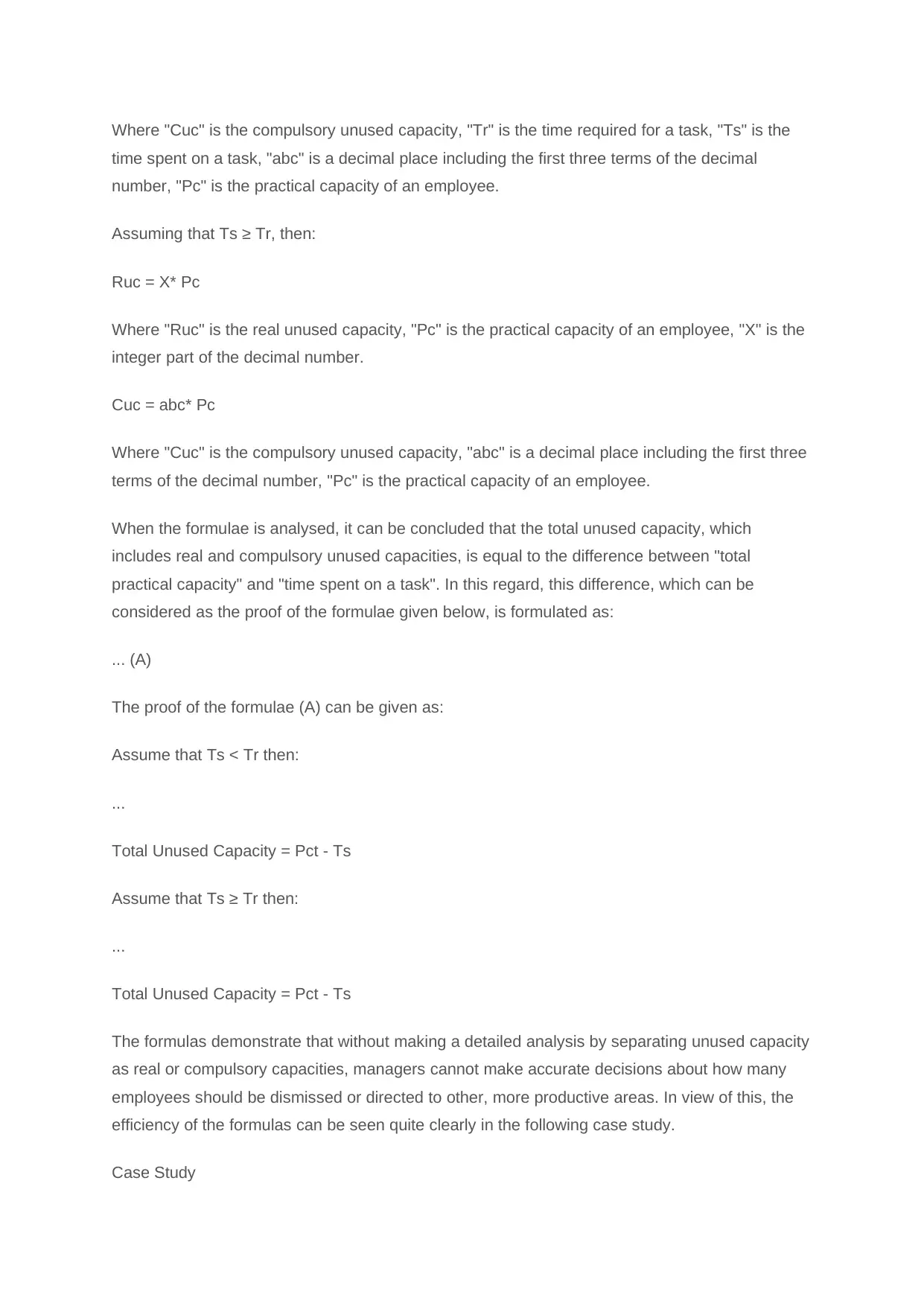
Where "Cuc" is the compulsory unused capacity, "Tr" is the time required for a task, "Ts" is the
time spent on a task, "abc" is a decimal place including the first three terms of the decimal
number, "Pc" is the practical capacity of an employee.
Assuming that Ts ≥ Tr, then:
Ruc = X* Pc
Where "Ruc" is the real unused capacity, "Pc" is the practical capacity of an employee, "X" is the
integer part of the decimal number.
Cuc = abc* Pc
Where "Cuc" is the compulsory unused capacity, "abc" is a decimal place including the first three
terms of the decimal number, "Pc" is the practical capacity of an employee.
When the formulae is analysed, it can be concluded that the total unused capacity, which
includes real and compulsory unused capacities, is equal to the difference between "total
practical capacity" and "time spent on a task". In this regard, this difference, which can be
considered as the proof of the formulae given below, is formulated as:
... (A)
The proof of the formulae (A) can be given as:
Assume that Ts < Tr then:
...
Total Unused Capacity = Pct - Ts
Assume that Ts ≥ Tr then:
...
Total Unused Capacity = Pct - Ts
The formulas demonstrate that without making a detailed analysis by separating unused capacity
as real or compulsory capacities, managers cannot make accurate decisions about how many
employees should be dismissed or directed to other, more productive areas. In view of this, the
efficiency of the formulas can be seen quite clearly in the following case study.
Case Study
time spent on a task, "abc" is a decimal place including the first three terms of the decimal
number, "Pc" is the practical capacity of an employee.
Assuming that Ts ≥ Tr, then:
Ruc = X* Pc
Where "Ruc" is the real unused capacity, "Pc" is the practical capacity of an employee, "X" is the
integer part of the decimal number.
Cuc = abc* Pc
Where "Cuc" is the compulsory unused capacity, "abc" is a decimal place including the first three
terms of the decimal number, "Pc" is the practical capacity of an employee.
When the formulae is analysed, it can be concluded that the total unused capacity, which
includes real and compulsory unused capacities, is equal to the difference between "total
practical capacity" and "time spent on a task". In this regard, this difference, which can be
considered as the proof of the formulae given below, is formulated as:
... (A)
The proof of the formulae (A) can be given as:
Assume that Ts < Tr then:
...
Total Unused Capacity = Pct - Ts
Assume that Ts ≥ Tr then:
...
Total Unused Capacity = Pct - Ts
The formulas demonstrate that without making a detailed analysis by separating unused capacity
as real or compulsory capacities, managers cannot make accurate decisions about how many
employees should be dismissed or directed to other, more productive areas. In view of this, the
efficiency of the formulas can be seen quite clearly in the following case study.
Case Study
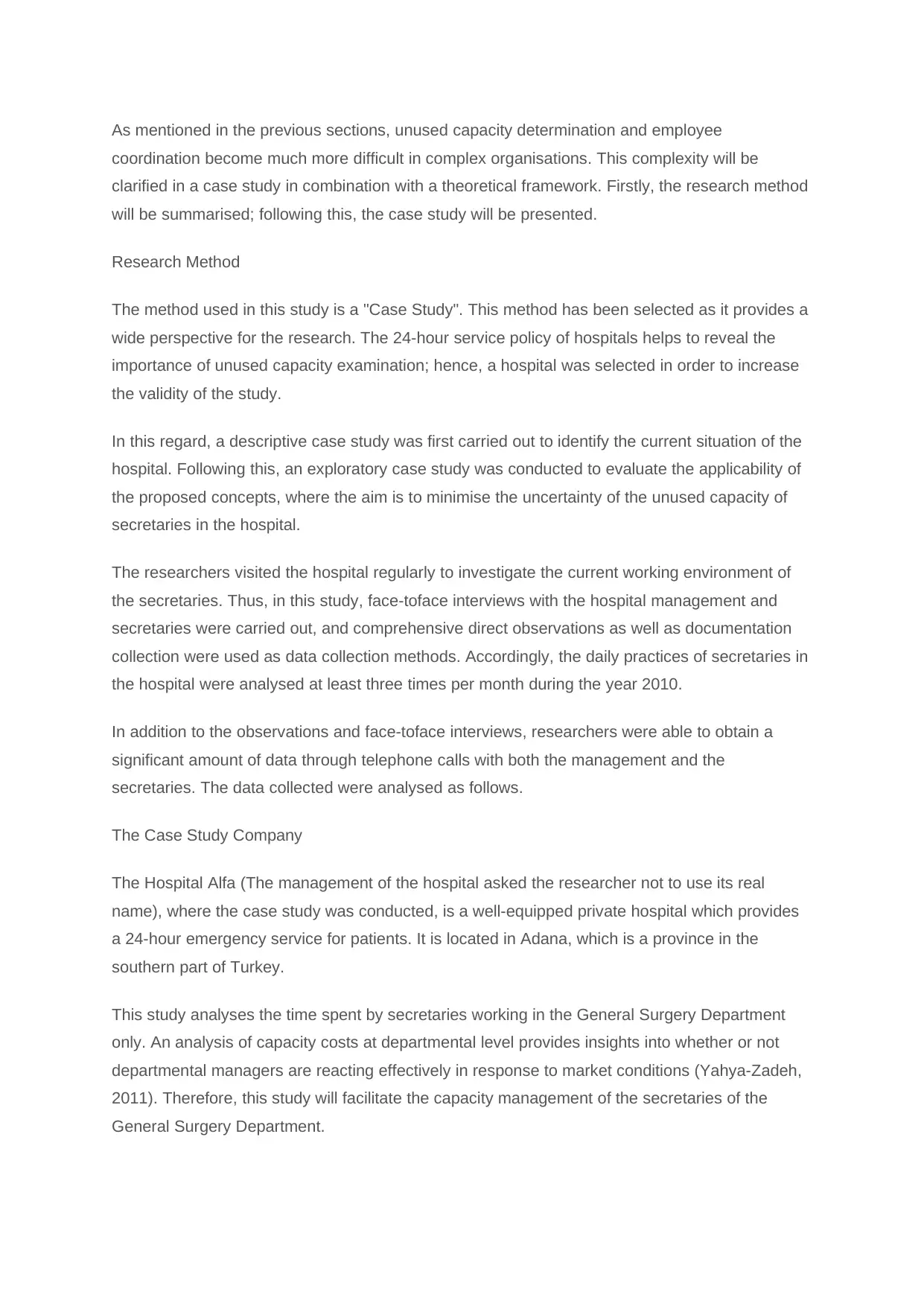
As mentioned in the previous sections, unused capacity determination and employee
coordination become much more difficult in complex organisations. This complexity will be
clarified in a case study in combination with a theoretical framework. Firstly, the research method
will be summarised; following this, the case study will be presented.
Research Method
The method used in this study is a "Case Study". This method has been selected as it provides a
wide perspective for the research. The 24-hour service policy of hospitals helps to reveal the
importance of unused capacity examination; hence, a hospital was selected in order to increase
the validity of the study.
In this regard, a descriptive case study was first carried out to identify the current situation of the
hospital. Following this, an exploratory case study was conducted to evaluate the applicability of
the proposed concepts, where the aim is to minimise the uncertainty of the unused capacity of
secretaries in the hospital.
The researchers visited the hospital regularly to investigate the current working environment of
the secretaries. Thus, in this study, face-toface interviews with the hospital management and
secretaries were carried out, and comprehensive direct observations as well as documentation
collection were used as data collection methods. Accordingly, the daily practices of secretaries in
the hospital were analysed at least three times per month during the year 2010.
In addition to the observations and face-toface interviews, researchers were able to obtain a
significant amount of data through telephone calls with both the management and the
secretaries. The data collected were analysed as follows.
The Case Study Company
The Hospital Alfa (The management of the hospital asked the researcher not to use its real
name), where the case study was conducted, is a well-equipped private hospital which provides
a 24-hour emergency service for patients. It is located in Adana, which is a province in the
southern part of Turkey.
This study analyses the time spent by secretaries working in the General Surgery Department
only. An analysis of capacity costs at departmental level provides insights into whether or not
departmental managers are reacting effectively in response to market conditions (Yahya-Zadeh,
2011). Therefore, this study will facilitate the capacity management of the secretaries of the
General Surgery Department.
coordination become much more difficult in complex organisations. This complexity will be
clarified in a case study in combination with a theoretical framework. Firstly, the research method
will be summarised; following this, the case study will be presented.
Research Method
The method used in this study is a "Case Study". This method has been selected as it provides a
wide perspective for the research. The 24-hour service policy of hospitals helps to reveal the
importance of unused capacity examination; hence, a hospital was selected in order to increase
the validity of the study.
In this regard, a descriptive case study was first carried out to identify the current situation of the
hospital. Following this, an exploratory case study was conducted to evaluate the applicability of
the proposed concepts, where the aim is to minimise the uncertainty of the unused capacity of
secretaries in the hospital.
The researchers visited the hospital regularly to investigate the current working environment of
the secretaries. Thus, in this study, face-toface interviews with the hospital management and
secretaries were carried out, and comprehensive direct observations as well as documentation
collection were used as data collection methods. Accordingly, the daily practices of secretaries in
the hospital were analysed at least three times per month during the year 2010.
In addition to the observations and face-toface interviews, researchers were able to obtain a
significant amount of data through telephone calls with both the management and the
secretaries. The data collected were analysed as follows.
The Case Study Company
The Hospital Alfa (The management of the hospital asked the researcher not to use its real
name), where the case study was conducted, is a well-equipped private hospital which provides
a 24-hour emergency service for patients. It is located in Adana, which is a province in the
southern part of Turkey.
This study analyses the time spent by secretaries working in the General Surgery Department
only. An analysis of capacity costs at departmental level provides insights into whether or not
departmental managers are reacting effectively in response to market conditions (Yahya-Zadeh,
2011). Therefore, this study will facilitate the capacity management of the secretaries of the
General Surgery Department.
⊘ This is a preview!⊘
Do you want full access?
Subscribe today to unlock all pages.

Trusted by 1+ million students worldwide
1 out of 75
Related Documents
Your All-in-One AI-Powered Toolkit for Academic Success.
+13062052269
info@desklib.com
Available 24*7 on WhatsApp / Email
![[object Object]](/_next/static/media/star-bottom.7253800d.svg)
Unlock your academic potential
Copyright © 2020–2025 A2Z Services. All Rights Reserved. Developed and managed by ZUCOL.



